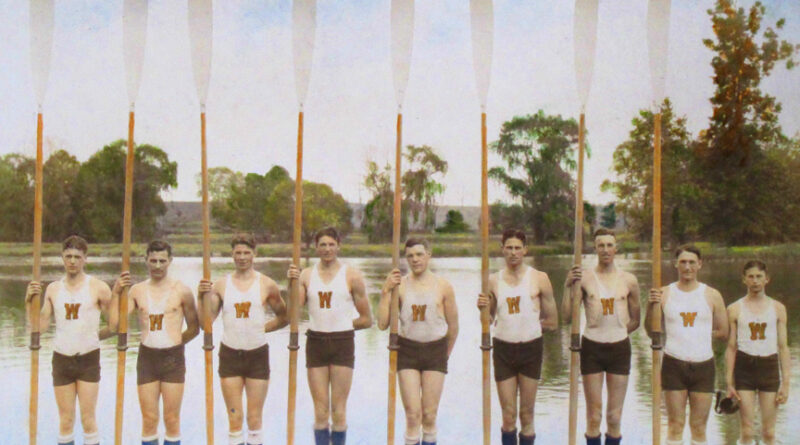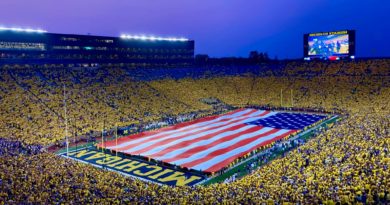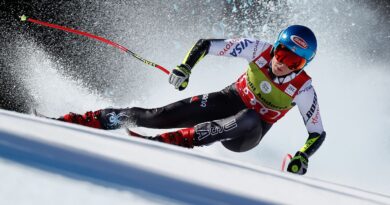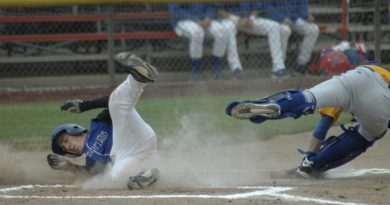A Historic Boy in a UW Boat
There it was. Hanging high on a wall at one of my favorite haunts. I recognized it immediately as an old vintage UW letterman’s sweater. It looked in nearly perfect condition. Known as a Big W Club sweater, this heavy wool letterman’s button-up just had to have a story. After some discussion with the shop’s owner, I was convinced that, yes, a story lurked around this piece of history that might even link it to a national championship.
In my search for its legacy, I first had to prove what era it came from. This was a dual track investigation that wasn’t as easy as one might think. It helped immensely that most of the original manufacturer’s label and the letter winner’s last name were still in the neck liner. I began by researching the woolen mill that made the sweater and found it was a local Seattle knitting company, Sportcraft, that had made the sweater. Sportcraft had bought out the Saxony Knitting Company, which is further borne out in the ‘Saxonyknit’ trademark that survived just enough to put two-and-two together. The Saxony Knitting Company existed into the mid-1920s, so I knew the time of manufacture could line up. Sportcraft was around through at least the mid-1950s, which led to an interesting red herring.
The second track was the last name of the cardigan’s owner, Condon. I researched through the University of Washington online archives to find there were two Washington Crew letter winners named Condon. Thankfully, there were no other letter winners by the name of Condon in any other sport. And, it turned out the Condon’s were father and son, Hal and Hal, Jr. Hal lettered in crew in 1924, ’25 and ’26. Junior lettered in 1955 and ’56. So, whose sweater was it? Actually, this was easier than one might think. The number of letters won by any individual is emblazoned by a stripe knit around the left bicep. This cardigan had three stripes, indicating the owner had won three letters. By that reckoning, it had to be Senior’s sweater.
To further convince myself I had the right Condon and, indeed, Hal’s sweater, I found archives of the UW Tyee yearbooks. Under the athletic sections were pictures of the Big W Club, the 1924, ’25 and ’26 Washington Crews, as well as fraternity pictures. I found pictures of Hal in every one of those spots, including him wearing a sweater resembling the one I now possessed in a 1926 group photo of the Big W Club. I also knew he had married Margaret Roberts, daughter of a UW prof during his senior year. Upon consulting the 1940 US Census statistics I found Hal Condon, Sr., his wife Margaret, daughters Beverly and Margarite, and 4-year-old son, Harold. If Harold, Jr. was born in 1935, that would make him 21 in 1956. That would fit right in with the years he would have lettered in Crew.
It’s both exciting and reflective to think I have the 98-year-old sweater of a Washington Crew three-time letter winner and two-time national champion. There is so much history embodied in that heavy wool, the kind of wool they don’t knit anymore. Hal Condon rowed with Al Ulbrickson, who coached the legendary UW 1936 Olympic Champions. They are currently featured in the movie, “The Boys in the Boat.” The book of the same title is much richer and deeper than the movie. If you haven’t, I encourage you to read it.
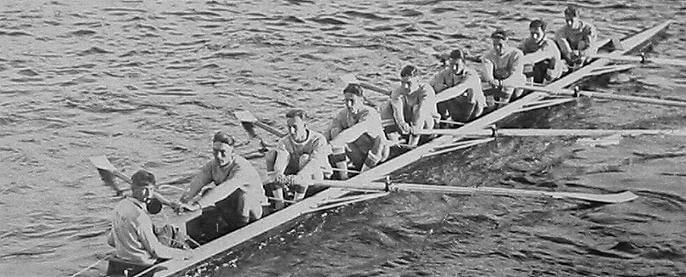
Rusty Callow was the UW Crew coach when Condon and Ulbrickson were rowing. Ulbrickson was only 32 when he led the Huskies to their epic victory at the Berlin Olympics. A who’s who of college rowing coaches filtered through Washington, beginning with legend Hiram Conibear, whose name still adorns the UW shellhouse on Lake Washington. That shellhouse is also where George Pocock built the world’s most sought after 8-man shells. In 1936, three more of Condon’s teammates, Tom Bolles, Harrison ‘Stork’ Sanford and Norm Sonju went on to coach at Harvard and Cornell, winning several national and international titles. Other Huskies also went on to coach at such prestigious programs as Yale, Navy, Cornell, Harvard, Penn, and California. At Washington, before Callow there was Hiram Conibear and Ed Leader, who in 1922 defected to coach at Yale. Conibear invented the famous ‘Washington Stroke’ and Callow perfected it. It was eventually copied everywhere. Callow coached the Huskies to national titles in 1923, ’24, and ’26. They lost by one second in 1925 to Navy, but avenged that with the victory in 1926.

In those early days, varsity races were four miles of all out rowing. Today’s are more of a sprint compared, at only 2,000 meters, or roughly 1-1/4 miles. Good crews these days can row those 2,000 meters in about 5 and a half minutes. The four mile champions of ’26 rowed up the Hudson River in 19:28. That’s an average of 6:05 per 2,000 meters – in a wood shell and oars. Today’s crews have far superior equipment, with superlight, slippery composite shells and carbon or fiberglass oars that store and release energy during each stroke. It’s a bit like pole vaulting with an aluminum pole or a fiberglass one. I don’t know this, but that 19:28 could also have been against the current. Imagine.
All these men are legends of the sport. It’s crazy how many of them started, rowed, coached and worked at the old Conibear Shellhouse that still resides, though remodeled and updated, on the Lake. You can tour the Shellhouse, see and feel history, victories in the Olympics (Ulbrickson ultimately coached 3 UW crews to Olympic medals), and a win against the Soviet Union in 1958, a victory as significant as the 1936 win over Hitler’s Nazi Germany.
Every time I look at or wear this sweater, I feel the greatness and dedication of those men. I get comments about it all the time. It’s a great piece of history and I get to wear it, touch it, feel it. That’s pretty special.
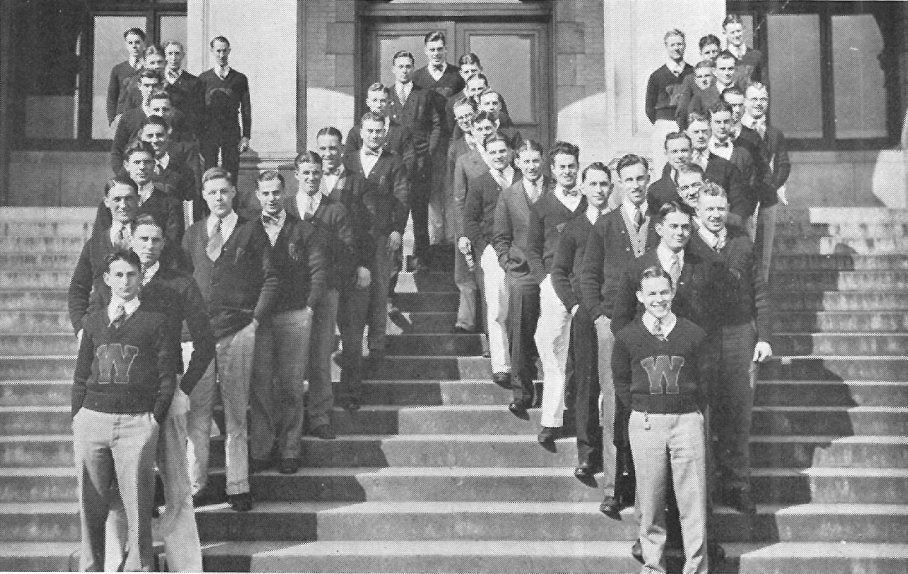
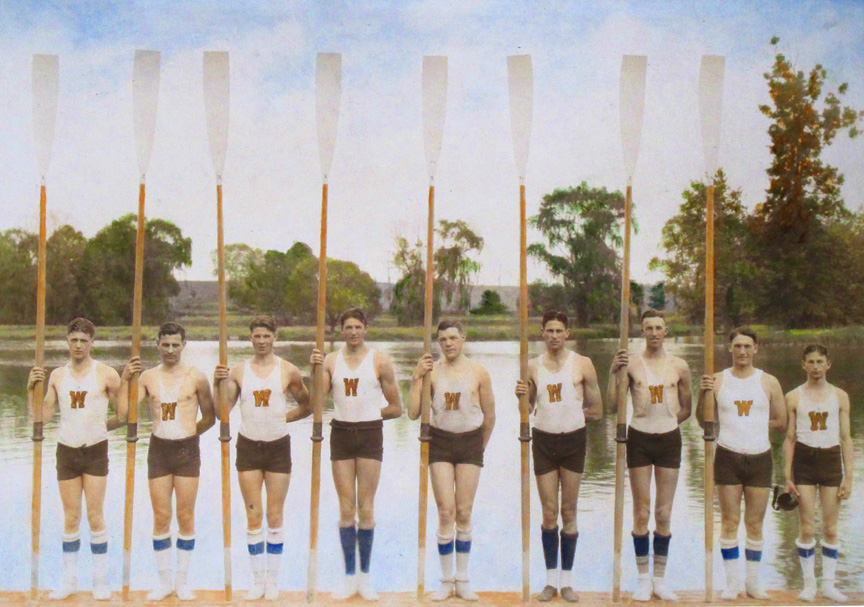
As for Hal Condon, the 1940 census said he was a Game Warden for the state of Washington and was still living in Seattle. I have more to find out about the man. AJ, who owns Husky Throwbacks, told me they had found the sweater after the family had recently given it away. Hmm. I want to know more. The search is on. Still, if I find out nothing more, it will remain a special, treasured memento of the school I grew up admiring and eventually graduating from. Go Dawgs! Woof!
The photos are all from UW Libraries Special Collections.

